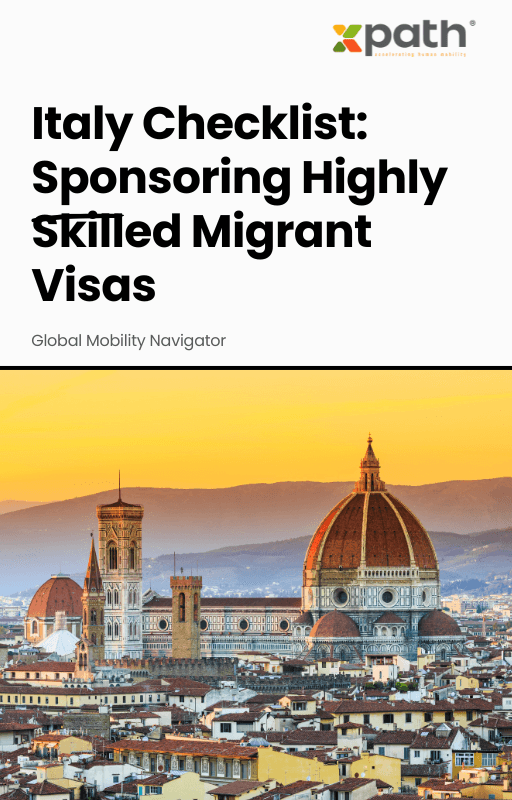Italy Checklist: Sponsoring Highly Skilled Migrant Visas
Grab a copy of a guide to international employee relocation
View E-bookLet’s be real—moving people across borders, even within Canada, can be a complex beast. The world of global mobility isn’t all about stamping passports and booking flights; it’s equally about understanding the fine print of compliance and tax residency. For HR pros, business owners, and the expats themselves, one of the trickiest puzzles is deciphering how provincial versus federal laws interact and impact your mobility strategy. So, how do you keep your company—and your workforce—on the right side of the law while still supporting global business ambitions? Let’s dive in.
Canada’s a federation, which means there are two layers of governmental authority at play: federal and provincial (or territorial). Each layer has its own compliance rules, tax rates, and residency requirements. If you’re managing employees who relocate between provinces, or who hop between Canada and international locations, you need to get comfortable with these overlapping frameworks. Federal rules cover the basics—think employment insurance, pension plans, and the Canada Revenue Agency’s (CRA) expansive reach. Provincial compliance, on the other hand, can differ wildly: payroll taxes, healthcare coverage, workers’ comp, and income tax rates all vary by province. Miss a step, and your company—or your employee—could land in hot water.
Let’s set the federal scene first. The CRA is the main tax authority, overseeing income tax, tax residency status, and the enforcement of various federal benefits or deductions. According to the Canada Revenue Agency, over 20% of global assignments fail due to compliance missteps, primarily around payroll and tax residency rules.
A worker’s federal tax residency status determines how they’ll be taxed—either as a resident (global income) or non-resident (Canadian source income only). Federal rules offer a checklist for “residential ties”—where your home, family, bank accounts, and personal property live. If most ties are in Canada, the CRA will deem you a resident.
But here’s the kicker: this does not automatically solve the provincial puzzle, especially with digital nomads, hybrid workers, or cross-provincial relocations.
Now toss in the provincial layer, and you’ve got a patchwork quilt. Each province has different income tax rates and, crucially, their own definition of residency for tax and healthcare purposes. Move from Alberta to Quebec? Prepare for a different payroll deduction schedule, new health plan registration, and varied employment law standards. This impacts both the employer and employee—mishandled transitions could lead to double taxation, benefit disruption, or audit nightmares.
The Canadian Federation of Independent Business highlights that payroll costs can vary by as much as 35% between provinces due to health taxes, workers’ compensation, and other levies. For companies with a mobile workforce, centralizing and automating compliance is key to avoiding headaches.
Compliance lapses aren’t just expensive—they’re brand-damaging. A Deloitte survey found that 40% of global organizations cited “managing changing regulations” as one of their top mobility challenges in 2022. The situation gets trickier post-pandemic, with remote work muddying residency definitions (think: “If my employee works from a BC ski lodge, are they BC-resident for tax? What about health insurance?”).
This is where global mobility solutions—like xpath.global—come in. Modern mobility platforms offer centralized dashboards to track residency status, automate payroll compliance across provinces, and reduce the risk of non-compliance fines. They not only make sure every T’s crossed and I’s dotted on jurisdiction-specific documentation but also handle the paperwork dance with government agencies, from healthcare to tax authorities.
Take, for example, a Toronto-based tech firm that needed to relocate 30 engineers to Vancouver in 2023 as part of a remote work initiative. By leveraging a platform like xpath.global, the company automated the provincial onboarding process—triggering payroll tax recalculations, updating health coverage, and instantly flagging incomplete documents. The result? Zero compliance breaches, and an estimated 25% saving on administrative overhead, compared with manual tracking.
Looking ahead, we’re likely to see even more complexity, especially as hybrid and remote work arrangements become normalized. According to PwC’s 2023 Global Mobility Survey, 68% of Canadian companies expect to increase their investment in compliance technology over the next two years, driven by frequent legal changes and workforce diversification.
Staying ahead means embracing flexible, tech-enabled solutions. A global mobility platform can become your command center—flagging changing definitions around taxable presence, synchronizing with federal and provincial updates, and helping you avoid “gotcha” moments when tax season rolls around.
In a fast-evolving mobility landscape, being proactive about federal and provincial compliance isn’t just a nice-to-have—it’s table stakes. Harmonizing tax residency and legal requirements is critical to retaining top talent, avoiding fines, and supporting a truly global mindset. With tools like xpath.global, you get a digital co-pilot, making compliance invisible so your relocation stories end happily (and penalty-free). If you’re serious about next-gen workforce management, now’s the time to supercharge your strategy with smarter mobility solutions.
What determines federal versus provincial tax residency in Canada?
Federal residency is assessed by the CRA based on “residential ties” like a Canadian home, family, and assets. Provinces add another layer, often using where you ordinarily reside on December 31. Both are necessary for correct tax and benefit attribution.
How do I ensure my remote staff meet compliance standards?
Automating the process with global mobility solutions like xpath.global reduces risk. These platforms monitor regulatory changes, keep your records current, and guide you through required updates at both federal and provincial levels.
What’s at risk if I get compliance wrong?
Penalties, double taxation, delayed employee benefits, or even legal audits. Getting it right not only saves costs but also supports talent retention and employee wellbeing.
Are rules changing with remote and hybrid work?
Yes. The move to remote work blurs provincial boundaries, making it even more critical to track where employees live and work. Mobility platforms help navigate this evolving terrain in real time.
Ready to transform your mobility program? Explore xpath.global’s solutions.

Italy Checklist: Sponsoring Highly Skilled Migrant Visas
Grab a copy of a guide to international employee relocation
View E-book